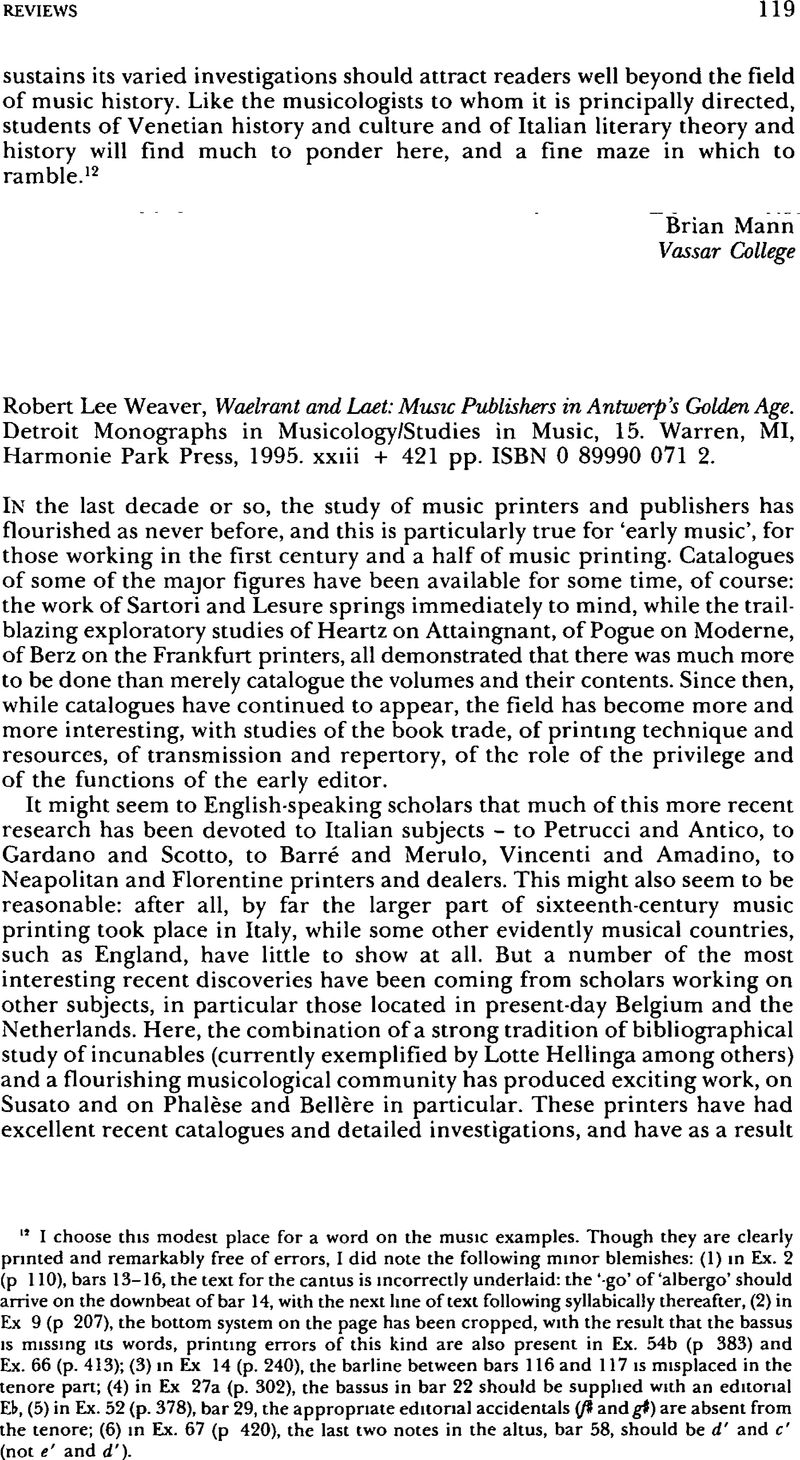No CrossRef data available.
Article contents
Review - Weaver Robert Lee, Waelrant and Laet: Music Publishers in Antwerp's Golden Age. Detroit Monographs in Musicology/Studies in Music, 15, Warren, MI, Harmonie Park Press, 1995. xxiii + 421 pp. ISBN 0 89990 071 2.
Review products
Published online by Cambridge University Press: 01 January 2020
Abstract

- Type
- Reviews
- Information
- Copyright
- Copyright © 1997 Oxford University Press
References
1 Without producing a bibliography of this material, which is available in Weaver's book reviewed here, I would mention the following. Kristine Forney, ‘Orlando di Lasso's “Opus 1” The Making and Marketing of a Renaissance Music Book’, Revue belge de musicologie, 39–40 (1985–6), 33–60, eadem, ‘Tielman Susato, Sixteenth-Century Music Printer An Archival and Typographical Investigation’ (Ph D, dissertation, University of Kentucky, 1978); Laurent Guillo and Jean-Michel Noailly, ‘Lettrines et ornements dans l'édition musicale aux XVIe et XVIIe siècles’, Ornementation typographique et bibliographie historique Actes du Colloque de Mons (26–28 aout 1987), ed. Marie-Thérèse Isaac (Brussels, 1988), 107–27, Donna Cardamone and David Jackson, ‘Multiple Formes and Vertical Setting in Susato's First Edition of Lassus's “Opus 1“’, Notes, 46 (1989), 7–24, Rudi Rasch, ‘Musica dis curae est The Life and Work of the Amsterdam Music Printer Paulus Matthysz (1613/4–1684)’, Quaerendo, 4 (1974), 86–99, Glenda Goss Thompson, ‘Henry Loys and Iehan de Buys, Printers of Music in Antwerp’, Tijdschrift van de Vereniging voor Nederlandse Muziekgeschiedenis, 32 (1982), 105–15, Henri Vanhulst, Catalogue des éditions de musique publiées à Louvain par Pierre Phalèse et ses fils, 1545–1578, Mémoires de la Classe des Beaux-Arts de l'Académie Royale de Belgique, 2nd ser., 16 (Brussels, 1990); idem, ‘Le contrat d'apprentissage conclu en 1562 entre Pierre Phalèse et Jean Laet’, From Ciconia to Sweelinck Donum natalicium Willem Elders, ed Albert Clement and Eric Jas (Amsterdam, 1995), 255–9, idem, ‘Lassus et ses éditeurs. Remarques à propos de deux lettres peu connues’, Revue belge de musicologie, 39–40 (1985-6), 80–100; idem, ‘Un succès de l'édition musicale: Le septiesme livre des chansons à quatre parties (1560–1661/3)’, ibid., 32–3 (1978–9), 97–120, idem, ‘Suppliers and Clients of Christopher Plantin, Distributor of Polyphonic Music in Antwerp (1566–1578)’, Musicology and Archival Research, ed. Barbara Haggh, Frank Daelemas and André Vanrie (Brussels, 1994), 558–604.Google Scholar
2 Weaver, RobertLee, A Descriptive Bibliographical Catalog of the Music Printed by Hubert Waelrant and Jan de Laet, Detroit Studies in Music Bibliography, 73 (Warren, MI, 1994)Google Scholar
3 See p 100, among other places, and the reference there to Susan Bain's dissertationGoogle Scholar
4 On p. 120 Weaver collects together some data for paper costs in northern Europe at the time his observation that paper was the most expensive part of the process, more costly than labour, leads directly to the argument (which he does not make) that it would be cheaper (in use of capital, as well as probably in absolute terms) to print a smaller edition and then prepare a second edition in two years’ time than it would be to print a large edition and tie up capital in unsold copies for three or four years On the other hand, Weaver (on p 277) adds another example to the long list of books remaining available for sale for many years, in this case, half a centuryGoogle Scholar
5 See p. 101 This is an argument that, I think, has a much more general application My comments on it in the present paragraph do not detract from the importance of the point, especially when considering printers who were establishing themselves in music and working in a geographical area that already had other music printers and publishers The manner in which Milanese or later Roman publishers of music concentrated on the home repertory is evidence of their determination to establish a speciality, even while Venetian printers were flooding the local market with the international standard repertory It would be logical therefore that such publishers would make the necessary contacts and would have more than one volume planned from the startGoogle Scholar
6 It is important to remember, however, that these large-scale books would have been relatively expensive – often involving distinct founts of type and special paper Many of them are known to have been special commissions, to carry particular dedications and otherwise to look like unusual operations. None the less, they are not likely to have had as great a sale as simple volumes of chansons or madrigals, the number of institutions with polyphonic choirs, any of which would not have bought more than one copy, cannot have equalled the numbers of individual musicians buying secular music.Google Scholar
7 Consider here the pattern whereby Marenzio's lighter villanellas appeared in octavo format (albeit upright in orientation), whereas his madrigals were published in the more conventional quarto. Most of the noted books of soumterliedekens are also in octavoGoogle Scholar
8 'The Music Publisher's View of his Public's Abilities and Taste: Venice and Antwerp’, paper read at the conference ‘The Antwerp Music Printers in the Sixteenth Century’, Antwerp, July 1995Google Scholar
9 Henri Vanhulst's observations on this point, on p. xxix of his catalogue of Phalèse's editions, are noted by Weaver (p. 104)Google Scholar
10 In the earlier passage he argues that there is not enough evidence to decide on how many typesetters were actually employed on any book It seems to me that the two discussions should be brought together, for each informs the otherGoogle Scholar


